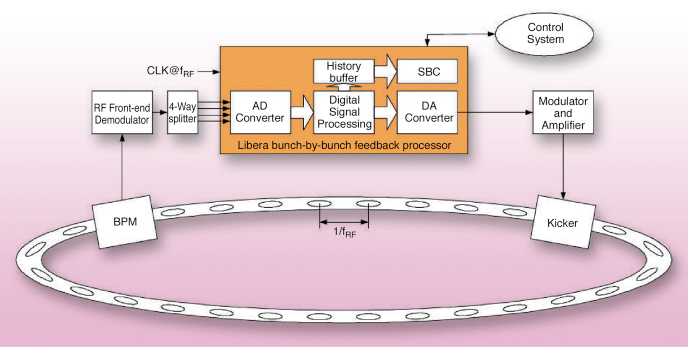- Home
- Users & Science
- Scientific Documentation
- ESRF Highlights
- ESRF Highlights 2006
- The X-ray Source
- Longitudinal feedback system
Longitudinal feedback system
The strongest longitudinal HOM of the RF cavities interacts with longitudinal coherent coupled bunch oscillations of the beam. When the frequency of such an HOM precisely coincides with the upper synchrotron sideband of a revolution harmonic, the resonant exchange of energy between the beam and the cavities may result in an oscillation that increases exponentially. Its growth time decreases with the beam current and when it becomes smaller than the natural synchrotron damping time of 3.5 ms, the beam explodes longitudinally. Even in cases where the instability is contained through non linear effects, the undulator radiation becomes unusable because of the strongly increased energy spread. Such instabilities have been recorded at currents as low as 40 mA. So far, the strongest HOM of the cavities are kept off such destructive resonances by means of a dedicated temperature regulation of the cavities to ± 0.05°C. With increasing current, however, more and more of the weaker HOMs become unstable and experience has confirmed that there are no temperature settings which allow us to escape from HOM driven instabilities above 250 mA. To damp such HOM driven longitudinal instabilities, we have designed and implemented a bunch by bunch longitudinal feedback system. This feedback system measures the deviation of the arrival time in a phase pick up with respect to the nominal bunch phase for each bunch, at a rate of 352.2 MHz. A fast digital signal processor then computes the value of a correction kick (acceleration or deceleration) which is applied to the same bunch but at another place around the ring circumference. The layout of the feedback system is shown in Figure 149.
 |
|
Fig. 149: Bunch-by-bunch feedback system for the damping of coupled bunch beam instabilities (from: www.i-tech.si). |
The components of this system have either been built at the ESRF (beam pick ups, RF front ends, kicker cavity) or subcontracted (kicker amplifier, digital signal processor). The procurement of the digital signal processor was done through a technical collaboration with the company Instrument Technology. This company customised electronics initially developed for the processing of BPM signals, called the Libera system, and turned it into a bunch by bunch signal processor. The new system has suitable data acquisition and processing rates, does data logging and has a high level programming environment for the coding of the feedback algorithm into the field programmable gate array (FPGA).
Thanks to this newly developed feedback system and to further tuning of the RF cavity working point, the target current of 300 mA was achieved in December 2006 for the first time, in uniform filling mode (the most challenging in terms of beam instability) without any sign of feedback saturation. The feedback sensitivity is such that the remaining oscillation of the damped instability has an amplitude less than one thousandth of the bunch length.



